Effective Approach Experience for Practical Training using Web-Based Platforms and Tools in the Context of the COVID-19 Pandemic
Control Systems Department, Technical University–Sofia, Branch Plovdiv, Plovdiv, Bulgaria
* Author to whom correspondence should be addressed.
Journal of Engineering Research and Sciences, Volume 1, Issue 4, Page # 22-27, 2022; DOI: 10.55708/js0104003
Keywords: e-learning, information systems, ERP systems, web-based design tools
Received: 28 January 2022, Revised: 08 March 2022, Accepted: 28 March 2022, Published Online: 12 April 2022
APA Style
Hrischev, R. (2022, April). Effective Approach Experience for Practical Training using Web-Based Platforms and Tools in the Context of the COVID-19 Pandemic. Journal of Engineering Research and Sciences, 1(4), 22–27. https://doi.org/10.55708/js0104003
Chicago/Turabian Style
Hrischev, Radoslav. “Effective Approach Experience for Practical Training Using Web-Based Platforms and Tools in the Context of the COVID-19 Pandemic.” Journal of Engineering Research and Sciences 1, no. 4 (April 2022): 22–27. https://doi.org/10.55708/js0104003.
IEEE Style
R. Hrischev, “Effective Approach Experience for Practical Training using Web-Based Platforms and Tools in the Context of the COVID-19 Pandemic,” Journal of Engineering Research and Sciences, vol. 1, no. 4, pp. 22–27, Apr. 2022, doi: 10.55708/js0104003.
This article is a result of the need to quickly and efficiently organize distance learning for students during the pandemic caused by COVID-19. Some e-learning opportunities provided by internet technologies, web-based platforms, online engineering tools are presented. Examples of training students in business information systems based on learning platforms and demo systems are presented, as well as the use of engineering tools for the design of production equipment on the websites of specialized companies. The common in these examples is the possibility of effective training without long preparation and additional expenses for the development of specialized learning platforms and simulators. The practical results of this non-standard approach to e-learning during a pandemic are also discussed.
1. Introduction
Coronavirus COVID-19 change our lives in all its aspects, including education. The accelerating e-learning in recent years from an opportunity for remote learning has become the just possible opportunity for effective learning in pandemic time [1]. This also applies to education at technical universities [2]. Carrying out the various technical specialties without access to auditoriums and work in laboratories, and on the other hand the observance of the topics and activities set in the curricula was a serious challenge. The only solution was to use cloud platforms for distance learning and access to specialized software simulators. But the development or implementation of specialized tools – Moodle, Office 365 from Microsoft, GSuite from Google, requires time and additional resources. It also takes time to train students and teachers. On the other hand, not every university has ability to install private cloud and simulation systems due to the budget restrictions, limitation of licensing rights and hardware and software requirements.
At the same time, everyone has access to the Internet with satisfactory quality via smartphone or computer. Therefore, there is an excellent opportunity to learn using shared resources on social networks, free web-based platforms, demonstration systems available via the Internet. The Internet provides a wide range of opportunities for interactive information exchange, online training, webinars, cloud collaboration technologies [3]. Many companies also provide free access demo systems, shared educational resources, and web-based design tools. Thus arose the idea of using such free platforms and web-based tools in the process of training students and professionals in various disciplines at universities during a pandemic.
This article aims to illustrate practical examples and results of the use of the Internet in the process of education students in the disciplines of Information systems in industry and Design of manufacturing apparatus.
2. E-learning of Information systems using shared resources in Internet and collaboration with vendors and implementers
The modern information systems are at the heart of human progress in recent years. This is especially true for the business and industry. Therefore, the education of students in the disciplines of Information systems is extremely important. The focus of computer science education is usually on the development of information systems (programming, architecture, databases, communication).
But businesses need not so much the development of new systems as the skills to implement, customize, administer, and effectively use existing, proven systems. The implementation of business management information systems by specialized software developers not only optimizes the processes in the organization, but above conveys the experience of leaders in the industry. Such are integrated management systems or ERP systems. They cover all (or almost all) information flows in the company and based on a sustainable information and communication infrastructure, are the perfect tool for complete business process management in real time. Enterprise Resource Planning (ERP) software has evolved over the years to include functionalities that cover all business operations. There are a wide variety of systems for small and large organizations, many of which offer integrated capabilities. However, identifying the ERP software that is most appropriate for a particular organization can be a difficult process, often involving many investigations and simulations. Students need to receive basic knowledge, and why not, practical skills to work with such information systems. Training engineers in various specialties to work with ERP systems is an important task for universities. But how to introduce students to the various integrated systems? The best way is to use shared learning resources and work with real systems. Therefore, most of the leading developers of ERP systems provide specialized training platforms.
2.1. OpenSAP training platform
In the process of training students in information systems in industry specialty is especially useful to use specialized platforms of the leader software company – SAP CE [4]. SAP is one of the world’s leading producers of software for the management of business processes, developing solutions that facilitate effective data processing and information flow across organizations. This is the most widely used ERP system in the world and therefore its knowledge gives a competitive advantage to engineers who have experience working with this system.
OpenSAP [5] is an Enterprise platform for massive open online courses (MOOCs) – Figure 1. OpenSAP is provided by SAP and hosted at the Hasso Plattner Institute in Potsdam, Germany. Every student can enroll for free in courses, which are provided free of charge. While the MOOC concept is already quite popular in academia, SAP is one of the first companies to build a platform for training and adopt it for business-related training purposes. Compared to most of e-learning formats, OpenSAP courses return to tried and trusted classroom concepts and transfer them to an online medium. It a typical learning process – courses have a defined duration; the courses are based on lectures (pdf and video). Students need to submit homework on a weekly basis and adhere to deadlines. The homework is graded and gives points required to the final achievement. The students have opportunity to discuss the course content in an online forum.
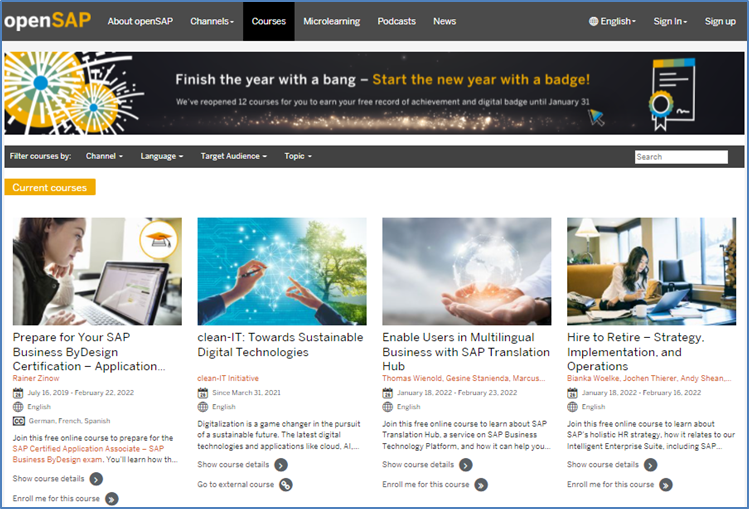
In pandemic time when students are more time at home it’s a very useful opportunity to receive additional knowledge. Timely acquaintance of students with this type of opportunity for free training in business management systems leads to higher engagement and motivation of students.
The experience of the last three years in our university shows that 15-20% of students manage to complete the course they have chosen and receive an international certificate. This certificate is a significant advantage in the job search of young engineers.
2.2. SAP University Alliances Learning platform
Universities training students in ERP systems and SAP can join the SAP University Alliances community [6]. The SAP University Alliance Learning Center -Figure 2, provides courses and simulators for organizing exercises in the curriculum. The developed simulators for training to work in the SAP modules give students not only the opportunity to be familiar with the working interfaces and functionalities, but also to acquire practical skills for performing most working operations.
All operations in a selected module are presented, performed by students and their work is evaluated. The simulators allow for students to acquire practical skills for working with a real system, and professors to assess the acquired skills. In Figure 3 is present one of simulators – Sales & Distribution (SD) module of SAP version R/3, provided from SAP University Alliances learning platform.
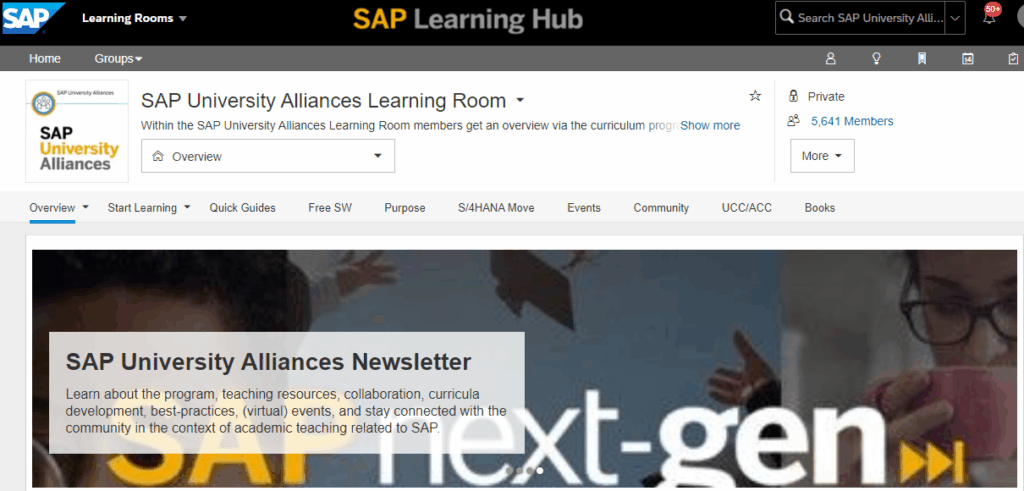
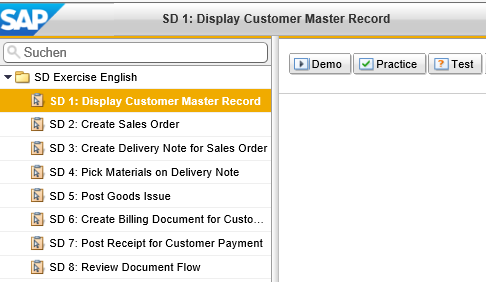
Using these simulators becomes an exciting experience for students, because it is no different from working with a real ERP system, while at the same time together with the accumulation of knowledge allows students to improve their practical skills. On the other hand, it allows the professor to introduce a competitive element in the exercise process. The result of this type of training is better engagement and motivation of students.
2.3. Use of free and demo cloud-based integrated information systems for remote learning
Many developers of business management software companies provide demos of the systems SAP HANA, Oracle Enterprise Resource Planning, Unit4’s Business World ERP, Microsoft Dynamics 365, Cetec ERP. However, they cannot be used for training because they usually require hosting, installation and additional configuration. There are also open-source ERP solutions out there. The training of students is not always appropriate to be conducted in English, because most of the specialties are taught in Bulgarian. Therefore, after careful investigation we decide to use demonstration version of ERP system, hosted from Bulgarian software company developer of ERP systems – bg ERP [7]. The main screen is shown in Figure 4.
The developer of bgERP, Bulgarian software company Experta ltd. hosted for our student fully functional copy for training purposes, accessible remotely from everywhere by phone, tablet, computer. This solution allowed the professors development of exercises for remotely trained in administration of the system, distribution of access and permissions for users. Roles and functionalities are defined to demonstrate the interaction of the different modules of the system tasks by functionalities and modules. For example, we set following users: CEO, Worker, Stock, Salesman, HR and Administrator. Role-playing games are preferable form of education and all students enthusiastically engage in the exercises.

To the presented using of shared platforms, we added the lectures by SAP implementers. Specialists from the biggest implementer of SAP in Bulgaria Scalefocus Ltd. prepare lectures for students on practical aspects of the implementation process.
The result of the applied teaching methods are the excellent results of the students trained in the discipline of Information systems in industry. Additionally, the certification of 5-7% of students is great opportunity for the new engineers.
3. E-learning using web-based tools for the design of electric drives of industrial apparatus
The electric drives of the manufacturing mechanisms are a basic and important element of the production apparatus. That is why the biggest manufacturers of electric drives are developing specialized tools for designing electric drives for various manufacturing devices. Of course, they are oriented to the basis of their own production – electric motors, gearboxes, frequency inverters and other equipment.
SEW-EURODRIVE, ABB, Mitsubishi Electric, SERVOTAK as a world leader in drive technology and pioneers in drive-based automation, provide online drive selection tools for various production mechanisms. The use of these tools makes it possible step by step to design electric drives of the main types of drives as elements of automation systems – conveyors of different types, transport mechanisms, different types of lifting mechanisms, pumping equipment, various servo drives and more. others. The companies provide access to web-based tools after simple registration without any restrictions.
These free tools are an excellent opportunity for e-learning of students in disciplines related to the design of electric drives of industrial apparatus, developing exercises without need of specialized simulators. Which are the used design tools in our practice?
3.1. Web-based tools for the design of electric drives of industrial apparatus
SEW-EURODRIVE USA provides access to a specialized PT Pilot web-based tool [8] for online design of drives of various production mechanisms – conveyors, lifting and transport mechanisms.
PT Pilot – Figure 5, is compatible with all major browsers for PC and MacOS. No installation or purchase required. PT Pilot is an advanced online selection tool that provides all the following functions: calculator and formulas for drive applications, includes thermal and mechanical evaluations of the operation of mechanisms, 2D or 3D electronic CAD files, prepares an offer with a net price, and allows online ordering the selected equipment and spare parts using implemented from companies ERP systems, SAP from example.
This possibility is a demonstration of connection between the two disciplines presented in this article – Information systems in industry and automated design and ordering of production apparatus and spare parts.
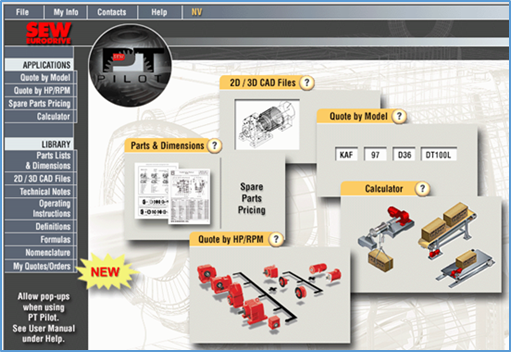
Specialized tool Calculator, part of PT Pilot, Fiure.6, provides the opportunity for preparation of exercises for training in the design of following manufacturing apparatuses as part of technological lines – belt conveyor, roller conveyor, travel drive, crane hoist, lift, palletizer, travel drive. In practice, this is a tool for automated design of machines and electric drives according to pre-set parameters of the technological process.
ABB is a leading global engineering company, one of the engines of industry transformation to achieve a more productive and sustainable future. By adding its own design software developments to its portfolio of production mechanisms, robotics and automation, ABB provides its customers with a finished product that expands the boundaries of technology, increases the efficiency of production. Part of the software tools provided free of charge online by ABB is the specialized tool DriveSize Web [9]. It contains current versions of the catalog of engines and drives of ABB.
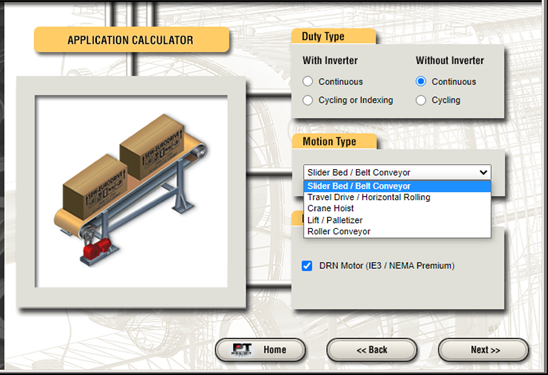
DriveSize, Figure 7, assists engineers in selecting optimal drives for variable speed production machines from ABB drives. DriveSize consists of a user interface, a computing part and product databases.
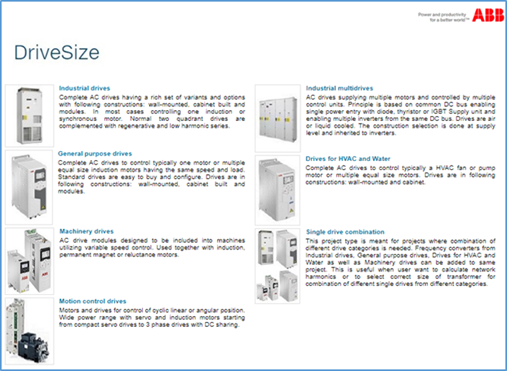
This tool is very convenient for conducting remote training of students in the design of positioning mechanisms, pumps and fans apparatus.
SERVOTAK’s engineering solutions focus on users who need precise actuators with superior quality and performance. The company’s goal is exceptional reliability, robustness and an innovative approach to problem solving. The Servotak website [10] consists of the web-based Engineering Calculator tool – Figure 8. This tool allows online design of various production devices – conveyors, turntables, elevators, vehicles.
The Engendering Calculator assists specialists in sizing different parts of the production mechanisms. Mathematical algorithms for calculating the parameters of the mechanisms and their electric drive are provided, as well as detailed interactive methods for calculations. Therefore, this application can be used as an engineering guide for future engineers.
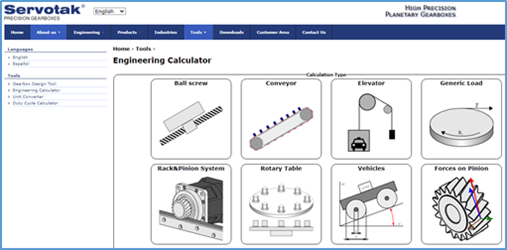
3.2. Web-based tools as part of e-learning in pandemic time
In the conditions of the pandemic, there was a need for rapid implementation of distance e-learning. In these conditions, the university proved E-Learning platform /usually Moodle/ as an excellent solution for sharing lectures, materials and conducting tests and exams. But what to do with laboratory exercises? Teaching students to design manufacturing apparatus and their electric drives without access to laboratories was a major challenge for faculty during the pandemic. Therefore, interactive online laboratory exercises have been developed based on the web-based tools presented on the SEW-EURODRIVE, ABB and SERVOTAK websites. Laboratory exercises were developed for the design of production mechanisms and drives for various production devices: transport trolleys, belt conveyor, roller conveyor, lifting mechanisms, palletizer, rotary table, elevator, pumps and fans. The laboratory exercises were conducted with students in the disciplines Automated Manufacturing Apparatus and Design of Electric Drive Systems. Each student in each exercise was given an individual task online, which they had to solve with the help of interactive tools on the company’s websites.
From the first exercise, there was great interest from side of the students. Most of them with passion and enthusiasm begin to study these tools on their own, to develop examples and send the results, designed as extracurricular activities.
The results from using these online tools are already in detail presented [11]. There are two positive trends in the use of these approaches:
- Student engagement increases. After the transition to distance e-learning and the presentation of new laboratory exercises, respectively, attendance increased by more than 30%.
- Higher success is achieved. Due to the increased interest and commitment of students, student grades increased by 17%. Assessment also takes place in an online environment with tests in Moodle or Google Form.
- In parallel with the learning process, students get acquainted with the official websites of industry leaders and their proposed training platforms and tools for designing devices in the field of control systems.
- Students learn to use web-based tools for interactive design. This allows them to compare different design methods. They discover the advantages and characteristics of design tools provided by different equipment manufacturers.
Without absolutes the role of e-learning better for students, the ability to use the Internet to attend classes, the use of real tools for the design of production apparatus and electric drives provided by companies, world leaders in the field of automated production, causes interest and commitment among students.
4. Conclusions
In the COVID-19 time, the Internet has become a natural environment for communication and sharing. But the Internet is not only an opportunity for social contacts, it is also one of the preferred ways to share knowledge in the form of available resources for learning and research in public and private networks. E-learning platforms and free specialized engineering tools of technology giants in various fields are an excellent opportunity to train students in various scientific and applied fields [3], [12]. The proposed examples of training in the disciplines of Information Systems in industry and Design of manufacturing apparatus and the results of this approach illustrate the benefits of using these tools in a pandemic for educational purposes. In this article presents only some examples in two disciplines, but this approach is also applicable in other areas of education, because platforms, shared materials and specialized tools for other engineering disciplines can be easily found.
- Robert Power, “E-Learning Essentials 2020”, Power Learning Solutions, 2020: ISBN: 978-1-9993825-2-0.
- Nicole Buzzetto-Hollywood, Advanced Principles of Effective e-Learning, Informing Science Press, USA, 2007
- M.Q. Huynh, U.N. Umesh, J.S. Valacich, “E-Learning as an emerging entrepreneurial enterprise in universities and firms”, Communications of the AIS, 2003, 12, 48-66.
- SAP SE official site https://www.sap.com.
- OpenSAP training platform https://open.sap.com.
- SAP University Alliances Learning platform https://community.sap.com/topics/university-alliances.
- bgERP official site https://bgerp.com.
- SEW EURODRIVE official site http://www.seweurodrive.com/s_ptpilot/.
- ABB official site https://new.abb.com/drives/software-tools/drivesize.
- SERVOTAK official site https://www.servotak.eu/tools.
- R. Hrischev, N. Shakev, “Using of interactive web-based electric drive design tools in e-learning in pandemic time”, IEEE, 2020 International Conference Automatics and Informatics (ICAI), pp. , DOI 10.1109/ICAI50593.2020.9311383.
- C. Odoyo, Samuel O. Olala, “Covid-19 Pandemic as a Catalyst to E-Learning Acceptance in 2020”, International Journal for e-Learning Security (IJeLS), Volume 9, Issue 1, 2020, pp.610-615, DOI: 10.20533/ijels.2046.4568.2020.0076
